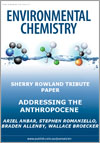EN15115Addressing the Anthropocene
Environmental context. We are entering an epoch – the Anthropocene – in which human activity is changing the face of the planet. To stabilise climate, we may consider deliberate intervention into Earth’s systems, on a global scale. Responsible stewardship requires that we develop a safe, economic and environmentally acceptable means of sequestering CO2 from the atmosphere.




